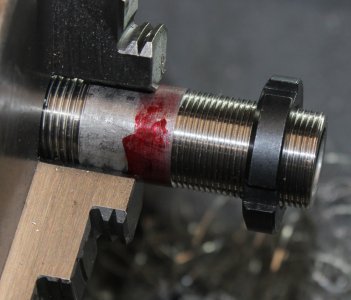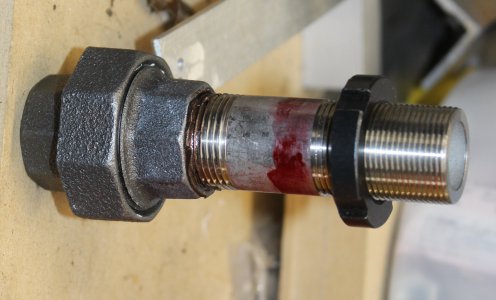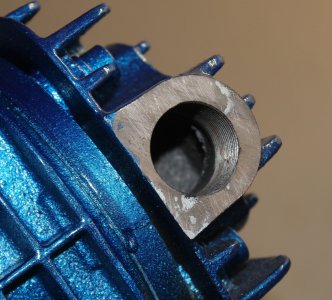You lost me, there. What am I doing with the punch and why?I like the copper washer idea mentioned above. You can control the position by the thickness of the washer. Once you have it where you want it, stake it in several places with a center punch or chisel. Mike
-
Welcome back Guest! Did you know you can mentor other members here at H-M? If not, please check out our Relaunch of Hobby Machinist Mentoring Program!
You are using an out of date browser. It may not display this or other websites correctly.
You should upgrade or use an alternative browser.
You should upgrade or use an alternative browser.
How do I seal this compressor?
- Thread starter lesrhorer
- Start date
- Joined
- Sep 2, 2013
- Messages
- 5,132
Once you have the fitting screwed into the casting in the position required, place the point of the center punch at the junction of the exposed thread and the compressor casting, and give it a smack with a hammer. Do this in several locations, and it prevent the fitting from coming loose. Mike
- Joined
- Feb 1, 2015
- Messages
- 9,645
Nine years ago, I replaced the pressure tank on our domestic water system. I installed a brass modular ball valve as a shutoff from the well and 1"npt fittings to match. I chose the modular valve because it had a separate threaded 1" npt modules so it function like a pipe union. I connected the fittings using Teflon tape and pressurized the system only to find it leaking. I pulled it apart and used Teflon pipe dope and connected everything. On pressurization, it still leaked. I pulled it apart again and this time used silicon RTV. It still leaked. Finally, I cleaned off the RTV and used epoxy. It hasn't leaked in nine years.I have some Permatex Ultra Red RTV Silicone. It is supposed to be good to 343C (650F). I think I would prefer to try that, unless the outlet temp exceeds 330C.
I have filed the outlet port by hand until it is as smooth and flat as I can make it by hand. Exactly how perpendicular it might be is another matter. I also ordered a 1" copper crush washer and a jamb nut. I can easily machine a groove into the nut to secure the washer. Hopefully one or the other of the RTV silicone or the copper washer will work. The 3/4" Schedule 80 nipple I ordered is stainless steel, so it should have no problem whatsoever with the heat. I have a 3" x 2.5" piece of Aluminum hex bar I am going to tap with 3/4" pipe threads and into which I will machine some fins for extra cooling.
It turned out that this USA manufacturer had cut imperfect threads so the water pressure was able to extrude the RTV through the resultant channel, allowing the leak. .
I found this thread sealant, which is supposed to be good to 982C (1800F). It probably won't seal the straight threads by itself, but this plus the copper crush washer should definitely seal, and it should wirk great on the rest of the pipe threads. I am going to machine an Aluminum cooler, and use 3/4" soldered copper pipe on the far side of the cooler. Of course, I will still double-check with a thermometer, but I don't think any of the pipes beyond the cooler will exceed the 220C (430F) melting point of the silver bearing solder I intend to use. If any of the solder joints get anywhere close, I will re-solder them with hard solder.
Oh, I see. I am using a jamb nut, so it should not be an issue.Once you have the fitting screwed into the casting in the position required, place the point of the center punch at the junction of the exposed thread and the compressor casting, and give it a smack with a hammer. Do this in several locations, and it prevent the fitting from coming loose. Mike
Oh, I would not hesitate to use epoxy if the temperatures were not as high as this might be, according to reports. There is no question it can make a better seal on a poorly machined connector than RTV.Nine years ago, I replaced the pressure tank on our domestic water system.
... Finally, I cleaned off the RTV and used epoxy. It hasn't leaked in nine years.
It turned out that this USA manufacturer had cut imperfect threads so the water pressure was able to extrude the RTV through the resultant channel, allowing the leak. .
Here is the completed manifold. It turns out the reported temperatures seem to have been a bit exaggerated. 'No big surprise, there. The high pressure cylinder head never went above 120C in a test run. OTOH, I am only running the compressor at 125 PSI, not its maximum rating of 175 PSI, and I am running it slower than its maximum rating of 850 RPM.
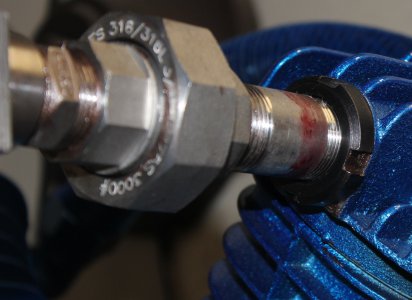
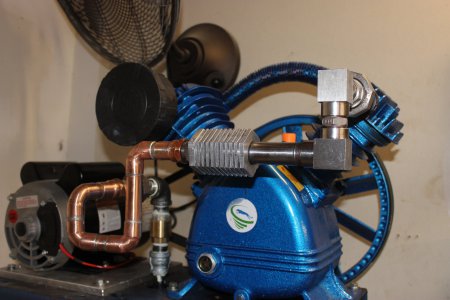


Last edited:
- Joined
- Sep 2, 2013
- Messages
- 5,132
Looks good. I like your sense of diversity. Copper, brass, galvanized, ductile iron, aluminum, stainless, black iron, and what looks like mild steel. It's like the united nations of compressors. Nothing at all wrong with running slower and less pressure, saves wear and tear. I run mine at 140, just because I like to live dangerously. Cheers, MIke


